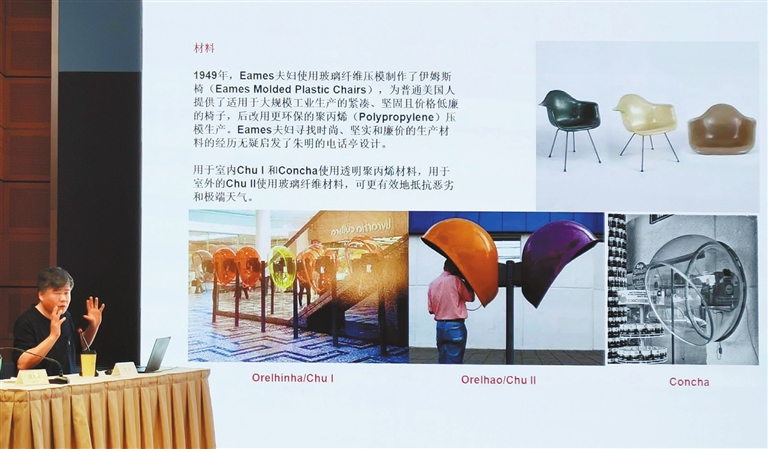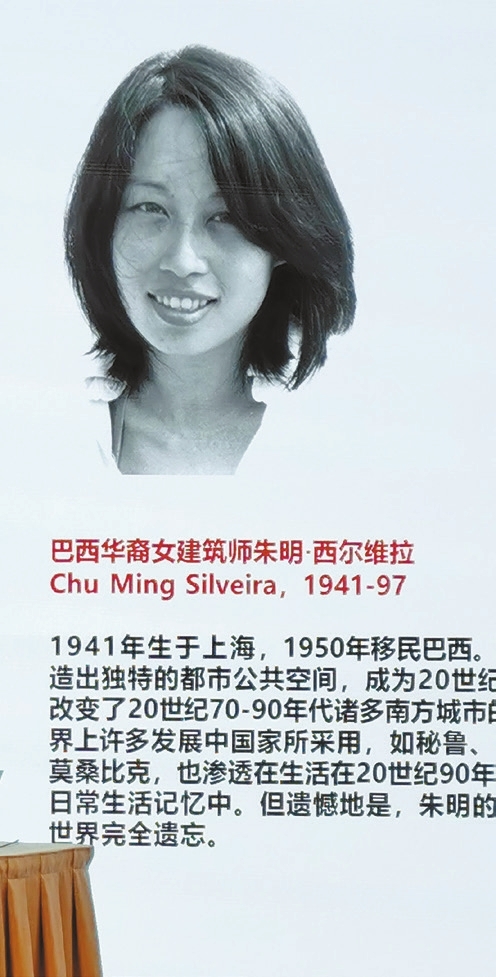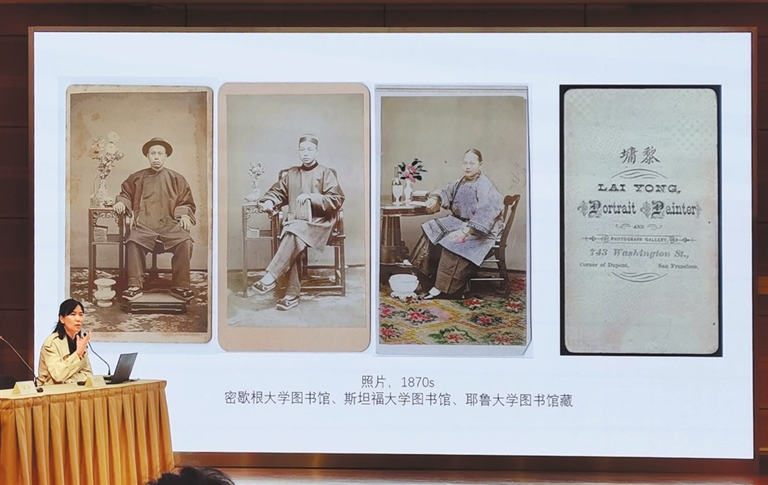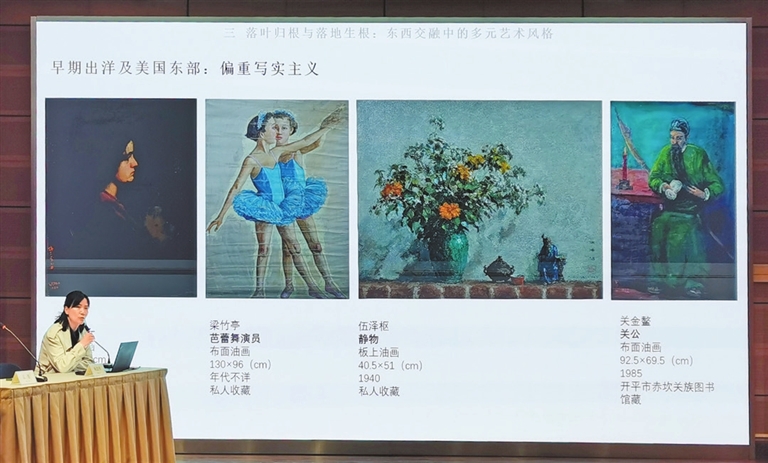



Cao Zhen caozhen0806@126.com SCHOLARS in the fields of art, architecture, anthropology, migration history, and cultural communication shared some lesser-known yet intriguing stories about overseas Chinese artists and architects during a symposium at the He Xiangning Art Museum on Saturday. As a sideline event of the art museum’s ongoing “Sixth Global Overseas Chinese Artists Exhibition,” the symposium was themed “Road to Gold Mountain: Chinese on Both Ends of the Earth and Modern Visual Writing,” focusing on these scholars’ studies on the lives and artistic experiences of Chinese individuals in the Americas since the 20th century. Pei Zhao, a visiting professor at University of Miami’s School of Architecture, gave a lecture titled “Building New World: On Chinese Latin American Architects,” examining the experiences and works of Chinese-Brazilian architect Chu Ming Silveira, Chinese-Cuban couple Julia León and José Antonio Choy, and Chinese-Uruguayan architect Cheung-koon Yim. He explored their experiences from the perspective of migration, architecture, and design histories. Pei introduced Brazil’s iconic egg-shaped telephone booth designed by Chu. The distinctive booths, nicknamed “big ears,” decorating the Brazilian sidewalks since the 1970s, take shape as lightweight oval hoods, prioritizing acoustics, along with user comfort, protection, and privacy. Similar semi-open telephone booths that combined functionality and aesthetics were also incorporated into the streets in China in the 1990s and 2000s. Pei observed that as a migrant, Chu faced challenges in securing a job as an architect so she worked in Brazilian Telephony Company’s engineering department. He emphasized the strategic nature of Chu’s career-building path. “While we may be drawn by well-known overseas Chinese architecture and design masters, we often overlook the remarkable achievements of lesser-known designers and architects,” Pei said. “These individuals embody the fusion and conflicts within diverse cultures, reflecting the struggles and compromises experienced by the migrants,” he added. Pei stressed the significance of focusing on immigration history in his research, noting that it offers insights not only into individual cases but also into the characteristics in cultural integration. This approach allows for a deeper understanding of the complexities and nuances inherent in the evolution of architectural and design landscapes shaped by migration and cultural exchange. Yang Huidan, an associate professor at the Guangzhou Academy of Fine Arts’ Art Museum, told a similar little-known story about painter and photographer Lai Yong during her lecture on Guangdong artists in the Americas in the late 19th century and the early 20th century. She said that Lai was the first documented Chinese studio photographer in California, with his studio listed in San Francisco directories as early as 1867. His most famous painting, dated 1870, a portrait of future San Francisco mayor Adolf Sutro, signified his notable success in the U.S. community. Furthermore, in 1873, Lai co-authored “The Chinese Question From a Chinese Standpoint” and presented it to the San Francisco Board of Supervisors, advocating against discriminatory treatment. Few of Lai’s artworks have survived possibly due to his return to China in the late 19th century. He then opened a photography studio in Guangzhou. Yang analyzed that many Guangdong artists in the Americas in the 19th century and the early 20th century were descendants of laborers or businessmen. Unlike their counterparts studying art in Europe during the same period, who aspired to reform traditional Chinese painting, the artists in the Americas faced the pressing need to sustain themselves financially before pursuing their artistic endeavors. Consequently, they have remained largely unrecognized in the Chinese and Western art history. Zhou Rong, a researcher from the Beijing Fine Art Academy, reflected on the impact of the “Contemporary Chinese Paintings” exhibition at the Metropolitan Museum of Art in the U.S. in 1948. She said that back then, the U.S. art community and collectors predominantly focused on ancient Chinese porcelain, bronzeware, and artworks predating the Song (960-1279) and Yuan (1271-1368) dynasties, while works from the Ming (1368-1644), Qing (1644-1911), and modern periods received little attention. The exhibition owed its success to the efforts of many Chinese immigrants in the U.S., and it significantly influenced the acceptance and recognition of modern Chinese art within the U.S. collecting community. You Tianlong, dean of Yunnan University’s Sociology Department and an associate professor, delved into Chinese actresses’ achievements in Hollywood from the 1920s to the present day. By analyzing notable figures such as Anna May Wong, Nancy Kwan, Lucy Liu, Zhang Ziyi, and Constance Wu, You pointed out that their success in Hollywood not only paved new paths for Chinese actresses, but also contributed to a diverse range of films for the global audience. Prof. Yang Xiaoyan from Sun Yat-sen University’s School of Art, Liu Daxian, a researcher at Chinese Academy of Social Sciences’ Institute of Ethnic Literature, Yuan Yan, an associate professor at Southwest Medical University’s School of Marxism, and Prof. Teng Wei from South China Normal University’s School of Chinese Language and Literature, also presented their unique insights into overseas Chinese artists, migration, and the profound influence of Chilean painter José Venturelli (1924-1988) on fine art education in China during their respective lectures. The “Sixth Global Overseas Chinese Artists Exhibition” at the He Xiangning Art Museum, running through May 5, showcases works by overseas Chinese artists residing in the U.S., Canada, Venezuela, Brazil, and Peru. The exhibition is part of the art museum’s long-time research on overseas Chinese artists, focusing on their education, lives, and the connections between their experiences and art. These artists, who have embraced different cultures in their lives, provide fresh and diverse perspectives to a new generation of artists and audiences alike. | 
